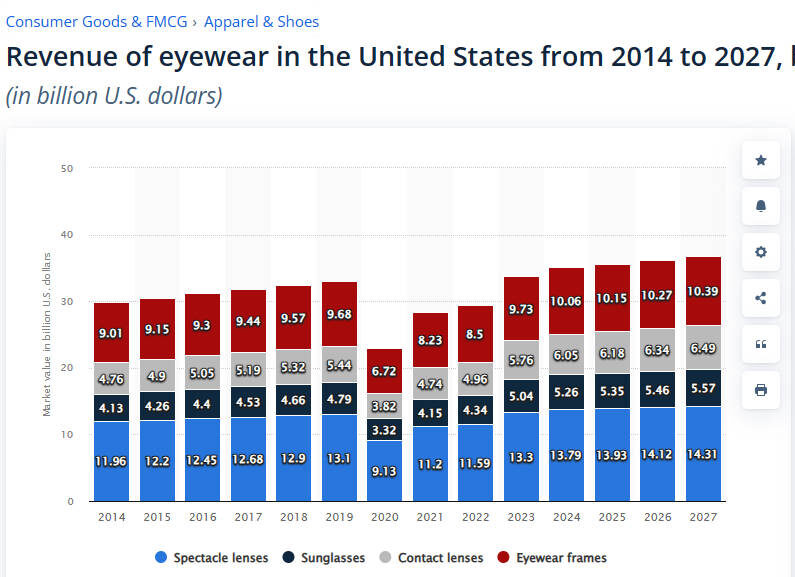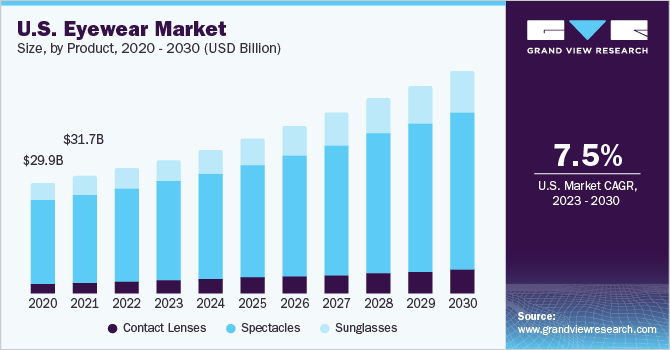How Much Do Optical Stores Make?
In the competitive realm of optical retail, your shop’s design plays a pivotal role in attracting customers and effectively showcasing your eyewear products. Whether you’re setting up a new store or revamping an existing one, here are some essential tips for creating an inviting and functional interior using wall-mounted optical displays:
Industry Overview
The optical industry has seen steady growth, thanks to factors like an aging population and increasing screen time leading to vision issues. This growth translates into potential revenue for optical stores.
Related: How to Open an Optical Store?
U.S. eyewear market - statistics & facts

Revenue Averages
According to recent data, the average annual revenue of optical shop businesses in the US is $525,000. However, this figure can fluctuate based on several factors such as location, store size, and the range of products and services offered.
What is the profit margin of the eyewear industry?
Global Eyewear Market Size and Growth:
- The global eyewear market was valued at USD 183.36 billion in 2022.
- It is projected to grow at a compound annual growth rate (CAGR) of 8.5% from 2023 to 20301.
Factors Driving Eyewear Market Growth:
- Changing Lifestyle Patterns: Increasing adoption of luxurious accessories, especially among millennials, strongly favors market growth.
- Fashion Trends: Eyewear companies are introducing new designs and patterns to quickly respond to current fashion trends and attract fashion enthusiasts.
- Brand Awareness: Marketing eyewear on social media platforms and using virtual try-on tools has contributed to global market growth.
- COVID-19 Impact: Remote working models and online learning led to increased screen time, driving sales of blue light-canceling and anti-fatigue lenses1.
Profit Margins in the Eyewear Industry:
- Typical profit margins in the eyewear industry range between 40% and 60%.
- Certain types of eyewear, such as designer brands and specialty lenses, tend to be more profitable due to higher price points and perceived value2.
Market Segmentation:
- The eyewear market includes various segments:
- Traditional Eyewear: Valued at USD 152.8 billion in 2022 with an expected 8.4% CAGR (2023-2030).
- Contact Lenses: Valued at USD 17.1 billion in 2022 with an expected 8.9% CAGR (2023-2030).
- Smart Glasses: Valued at USD 1.2 billion in 2022 with an impressive 27.1% CAGR (2023-2030)
- The eyewear market includes various segments:

Profitable Segments
- Among these products, spectacles (prescription glasses) are the most lucrative in the eyewear market.
- The total revenue share of spectacles eyewear is more than 52% in 2022.
- Contact lenses accounted for more than 26% of revenue share in the same year
What is markup on glasses?
Eyeglasses Markups:
- The markup on eyeglasses can be astonishingly high. According to former executives from LensCrafters, glasses are marked up nearly 1,000 percent!
- For context, designer frames can cost upward of $400, while standard glasses from companies like Pearle Vision start at around $80.
- The eyewear startup Warby Parker disrupted the market by offering more affordable options, but even their glasses start at $95.
- However, the truth is that you can find amazingly good frames with quality comparable to Warby Parker for as little as $4 to $8. And if you’re after designer-quality frames, you can get them for around $15.
Industry Giants and Price Gouging:
- The main culprit behind these high markups is the eyewear giant EssilorLuxottica.
- EssilorLuxottica essentially controls the industry, and its most popular brands include Oakley and Ray-Ban.
- Luxottica, an Italian glasses company, owns a spree of acquisitions, including Sunglass Hut, Pearle Vision, and Cole National (which owns both Target and Sears Optical).
- Luxottica also holds licensing rights for designer eyewear from brands like Prada, Chanel, Coach, Versace, Michael Kors, and more.
- If you buy glasses from a retail store in the US, chances are they were made by Luxottica.
- In 2017, Essilor acquired Luxottica for about $24 billion, creating a merged entity called EssilorLuxottica.
- This merged company has been called a monopoly, with a worth of around $50 billion, selling close to a billion pairs of lenses and frames annually1.
Profit Margins:
- The average markup on eyeglass frames is approximately 250 percent.
- While this may vary depending on the retailer and brand, it highlights the significant profit margins in the industry.
- Remember, when you’re paying for glasses, a substantial portion of the cost goes toward these markups and not just the actual production and quality of the frames and lenses.
Strategies for Success
To maximize profitability, optical stores can:
– Diversify product offerings to cater to various customer needs.
– Implement efficient inventory management to reduce waste.
– Offer a mix of high-end and affordable frames to attract a broader customer base.
– Keep staffing costs in check by considering alternative business models like franchising.
Conclusion
Optical stores have the potential to be quite profitable, with average revenues suggesting a strong market presence. By managing costs effectively and employing strategic business practices, optical store owners can turn a clear vision into clear profits.
Share:
Table of Contents
Shop Fixtures Manufacturer
We are a manufacturer of display products established in 1995 in Guangzhou, China. We specialize in a wide range of retail store fixtures,including display case,showcase,racks,counters,stands , etc. Providing customers with one-stop merchandising solutions.
Recent Posts
Subscribe to Newsletter
Get all the latest information on shop design ideas, sales and offers. Subscribe to the newsletter:



